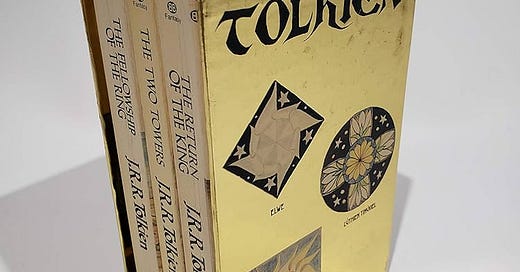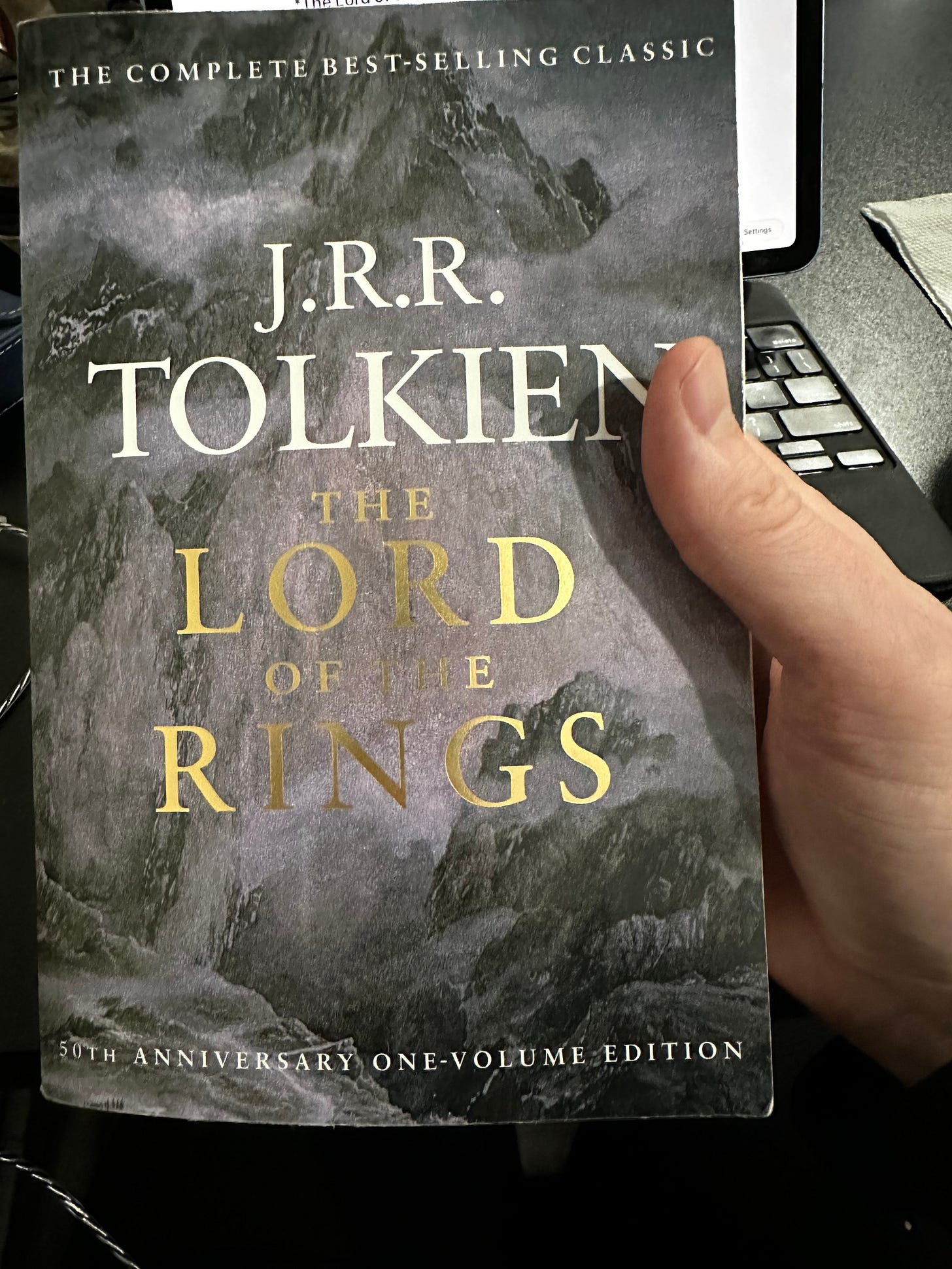In the late summer of 1979, I was nine years old. I had blazed through C. S. Lewis’s Chronicles of Narnia, mostly oblivious to the Christian allegory. (Those of you who read my recent series on Prince and the Icelandic sagas will sense an emerging theme of young Halbrooks completely missing heavy-handed religious messages.) I talked my parents into buying me a boxed set of Tolkien’s The Hobbit and The Lord of the Rings. They were hesitant and suggested that I get a copy of just The Hobbit, the animated movie of which my father and I had recently watched. What convinced them was my economic argument: they had bought me each of the Narnia books individually as I finished them, but it would have been cheaper had they simply purchased the boxed set up front.

What we didn’t realize at the time was that while The Hobbit is certainly a children’s book, The Lord of the Rings is not—which is not to suggest that children who are so inclined shouldn’t read it, but rather that parts of it may be rough going for a nine-year-old. It starts out fine, with the title of the opening chapter, “A Long-Expected Party,” an obvious reference to the first chapter of the earlier book, “An Unexpected Party.” It begins in tone similar to that of The Hobbit, and that tone returns from time to time, but something begins to happen as the reader joins Frodo on his journey: we travel not only across the map of Tolkien’s Middle-Earth but also through a range of literary styles and genres, as the narrator, who had been such an avuncular companion through the course of the earlier book, turns more and more serious.
There are reasons for this change, but they are complicated. If you read the early drafts of the first part of LOTR, it becomes clear that he had, indeed, originally set out to write the sequel to The Hobbit that his publisher had expected, but he wrote himself into something else indeed. As Tolkien himself famously wrote in his Foreword to the Second Edition, “This Tale Grew in the Telling” (page xxii). (The edition from which I will be providing page numbers throughout the challenge is the 50th-Anniversary one-volume edition, pictured below.)
What did it grow into? According to Tolkien, “it became a history of the Great War of the Ring and included many glimpses of the yet more ancient history that preceded it.” The writing became suffused with the spirit of the world (and the languages) that he had spent the previous three decades creating in his spare time, his eccentric hobby that filled countless notebooks with his spidery hand, going back to his time in the trenches in the First World War.
It is in that blending, however, that he unwittingly produced one of the bestselling books of the twentieth century. The Hobbit, on its own, is a delightful children’s book; the languages and mythologies of Middle-Earth, on their own, are perhaps of interest to philologists and world-building enthusiasts. It is in the melding of these two disparate literary universes, however, that Tolkien created a literary monument that continues to excite readers of all ages almost seventy years after its publication. My friend
, who will be joining our challenge, expressed to me some trepidation upon returning to the book after several decades: “So many years since I read it. Will I be disappointed? Can I even read anything so long??” A day or two after having started her reread, however, she texted me a picture of her book, opened to “The Council of Elrond,” more than halfway through The Fellowship of the Ring, and wrote: “Still a page-turner.”If Catherine’s experience is typical of those who read this book, and I think that it is, then this reading challenge will be a pleasure. If you are reading it for the first time, then you have a treat in store. If you are reading it for the second or fifth or twenty-third time, then I obviously don’t need to convince you of this.
So why do you need this challenge at all in order to read the book? Well, you don’t, of course. Millions of people have done it before. I think, however, that there will be value in reading it together and discussing it on any number of levels. Here is what the next nine weeks will look like:
Each Wednesday, I will publish an essay on the week’s reading, focusing on some theme, topic, or critical perspective. If you joined the Beowulf challenge, then you have some idea of what this will look like. These essays will explore Tolkien’s obsession with language, his work in medieval literature (including Beowulf), his proto-environmentalism, and his facility with traversing different literary styles and genres in the context of his narrative. These essays will be free to all readers, and comments will be open to everyone.
Also, for paid subscribers, I will publish an additional “challenge” post, which will include close readings, discussion questions, and will generally get more into the weeds. I hope that some of you will consider upgrading your subscriptions in order to participate in this part of the project. I will be running a 30% discount on annual subscriptions through March 13th, the first day of the challenge.
Whatever your level of engagement, however, I am happy to have you joining us our “Fellowship” on this journey from the Shire to Mordor. Let’s get stuck in. Put on your hiking boots and your reading glasses.
For week one, read through The Fellowship of the Ring, Book One, Chapter VII, “In the House of Tom Bombadil.” Please don’t skip the “Foreword to the Second Edition” or the “Prologue.” The Foreword includes Tolkien’s famous remarks on allegory and gives a real sense of his literary aesthetics, and the Prologue is a strange delight, a kind of travel guide to The Shire. Also, I suggest paying close attention to some of the bits you may be inclined to skip, like the detailed descriptions of landscapes, for example. We will be discussing some of these moments, which a twenty-first-century editor would surely have cut mercilessly, and which I will argue are essential to the book’s effect on the reader.
I look forward to wandering through this remarkable book together. And remember, “not all those who wander are lost.”
Thanks for reading, from my fancy internet Pony Express to yours.







I am a HUGE LOTR fan, I re read the books every so often and am also a HUGE fan of the Peter Jackson movies. (Ok, ok...I will admit that Orlando Bloom dressed up as Legolas is my seekrit Elf boyfriend.)
Guess I need to hit that subscribe button!
Substack suggestions work in mysterious ways - I've been looking for an excuse to dive back into the Lord of the Rings, and suddenly, this post appeared on my homepage! Excited to join this journey in community with fellow readers.